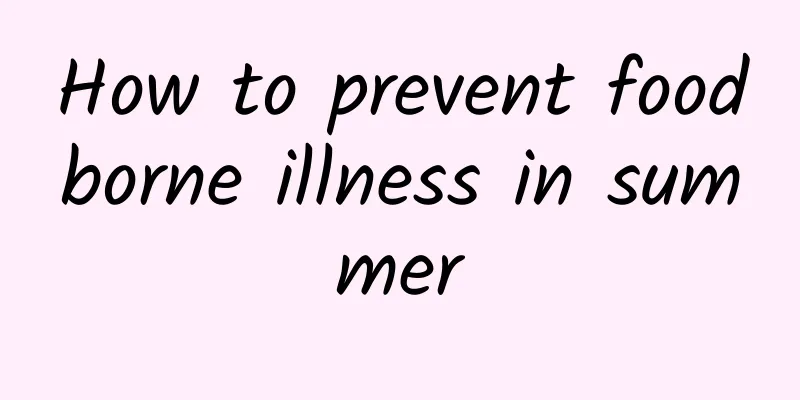How to prevent foodborne illness in summer

|
Summer is hot and rainy, and is a season when bacterial, toxic animal and plant, and fungal foodborne diseases are prone to occur and are most common. The following are tips for risk factors and preventive measures for common foodborne diseases in summer: 1. How to eat cold dishes and braised food safely? In hot weather, many people like to eat cold food such as salads and braised food. Since salads do not need to be heated during processing, braised food does not need to be heated again during the secondary processing after cooling. This type of food has high requirements for the sanitary conditions of raw materials and production and processing. If there is any negligence, it is easy to be contaminated by pathogenic microorganisms and cause foodborne diseases. When consumers buy cold dishes and braised food, they should choose qualified catering units with good hygiene conditions, and not buy from unlicensed vendors. Pay attention to purchase on demand and avoid long-term storage. When making cold dishes and braised food at home, use fresh raw materials. Raw materials that can be heated should be heated thoroughly, and protection should be taken during the cooling process; vegetables, fruits, etc. that cannot be heated should be thoroughly washed. During the processing, knives, cutting boards, tableware, etc. should be kept separate from raw and cooked food, and they should be eaten as soon as possible after processing. 2. How to eat seafood safely? Animal seafood such as fish, shrimp, crab, and shellfish are particularly susceptible to contamination by a halophilic bacterium, Vibrio parahaemolyticus. When these seafood are not handled properly (not fully cleaned, or cross-contamination between raw and cooked foods), or eaten improperly (raw or half-cooked, etc.), they can easily cause intestinal infections. When buying seafood, be sure to store it separately from other foods. If it cannot be processed immediately after purchase, it should be placed in the refrigerator as soon as possible. When storing seafood in the refrigerator, be sure to separate raw and cooked seafood. When handling seafood, use dedicated knives, chopping boards and containers to avoid cross-contamination during processing. When cooking seafood, cook it thoroughly. 3. What should you pay attention to when eating legume vegetables? Summer is the season when kidney beans, beans and other types of beans are on the market. Raw beans contain saponins and hemagglutinins. Under normal circumstances, sufficient heating can destroy their toxins and generally will not cause poisoning. However, if you pursue a "crisp" and "green" taste and appearance too much, or process too much at a time, stir-fry unevenly, and heat incompletely, it will cause poisoning after consumption. When processing beans, be sure to cook them thoroughly to prevent poisoning. 4. How to prevent foodborne rhabdomyolysis syndrome? The specific cause of foodborne rhabdomyolysis syndrome is still unknown, but epidemiological studies have found that the disease is related to the consumption of animal aquatic products such as crayfish, freshwater cod or buffalo fish. Summer is the peak season for crayfish consumption. Consumers can pay attention to the following aspects when enjoying the delicacy to reduce the risk of disease: First, choose fresh and reliable ingredients, and purchase fresh crayfish through regular channels such as farmers' markets, supermarkets and e-commerce with legal business qualifications. Do not eat, buy or catch crayfish of unknown origin or wild crayfish. Second, clean them thoroughly before cooking. The gills of crayfish absorb a lot of pathogenic microorganisms. It is best to cut off the gills and scrub the shells and the roots of the claws with a brush. Third, be sure to cook thoroughly and avoid excessive consumption at one time, especially for people with allergies or when they feel they are in poor physical condition (such as overwork, taking medication, etc.). 5. How to prevent poisoning from wild poisonous mushrooms? The hot and rainy summer is the peak growth period for wild mushrooms, and also the peak period for poisoning by wild poisonous mushrooms. There is no specific treatment for many poisonous mushroom poisonings, and the symptoms are severe, the onset is rapid, and the mortality rate is high. There is currently no simple and easy method to identify poisonous mushrooms. Some methods and experiences of identifying wild mushrooms that are circulated among the people are not reliable. The best way to avoid poisoning from poisonous mushrooms is not to pick, buy, or eat wild mushrooms of unknown origin or that you do not recognize. |
Recommend
Why do women have back pain?
The physiological structure of women is very diff...
Squamous epithelial cells
Why do pregnant women have higher levels of squam...
Can I do fire therapy during breastfeeding?
The principle of moxibustion is to use fire to st...
What to do if you haven't had your period for 38 days
Menstruation actually has a certain impact on wom...
What to do if you are infertile after having sex for half a year
The quality of life is much higher now, but there...
What should I do if the durian is not ripe enough after opening it too early? Can the durian flesh be softened after opening it?
Durian is one of the famous tropical fruits and i...
Picture of 34-week fetus in the belly
The most important way for the fetus to obtain nu...
Pain under right breast
Female breast cancer has a high mortality rate, a...
What happens if you don't have your period for three months?
There are many reasons for amenorrhea, and the fi...
What should you pay attention to when doing endometrial scraping?
For women, the most complex organ in the body is ...
Can I have a tooth extracted while breastfeeding?
Tooth extraction is a common way to treat dental ...
The best time to get pregnant after menstruation
Menstruation is the most important step in a woma...
The difference between pregnancy test strips and pregnancy test sticks
Nowadays, many female friends choose to use pregn...
Can breast cancer patients eat mango?
Mango is one of the well-known tropical fruits. M...
Does a new car need crystal coating? What are the benefits of car crystal coating?
Gold plating mainly protects the paint surface. C...









